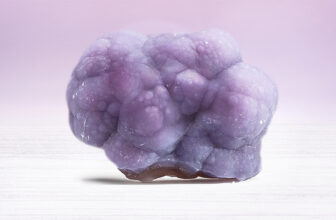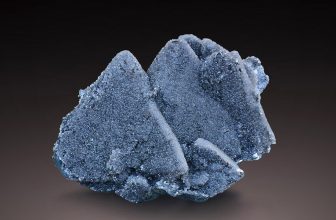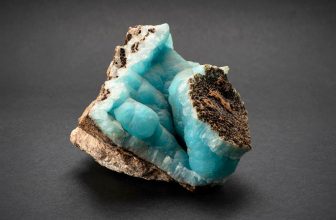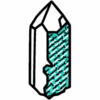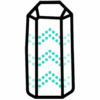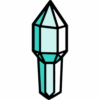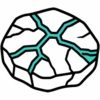The Living Curves of Botryoidal Crystals
 Clusters of Beauty, Born from Flow
Clusters of Beauty, Born from Flow
Imagine a mineral surface that looks like it’s breathing – covered in glossy, rounded bubbles that catch light like drops of dew on a grapevine. These are botryoidal formations, nature’s way of sculpting stillness into motion.
But what gives a stone this strangely organic, almost living texture? Why do some crystals form as sharp points, while others melt into gentle curves and folds?
The answer lies in the subtle dance between minerals, water, and time. The word botryoidal comes from the Greek botrys, meaning “grape,” and perfectly describes the way these minerals cluster into overlapping, rounded forms. Each tiny dome represents the story of mineral-laden water flowing through rock cavities, depositing layer after layer until the surface swells into a landscape of smooth spheres.
Unlike the rigid symmetry of prismatic crystals, botryoidal growth feels spontaneous – even playful. It captures the spirit of movement, as though the Earth itself once exhaled through stone. These forms appear in minerals like malachite, hematite, chalcedony, and goethite, each carrying their own unique color and texture.
The Science Behind the Shape
How does the Earth create something that looks so fluid from something as solid as rock? The process is as poetic as it is precise.
It begins deep underground, where mineral-rich water seeps through cracks and cavities in surrounding rock. Inside these spaces, tiny points – called nucleation sites – become the seeds of future spheres. Around each seed, microscopic crystals start to radiate outward.
Soon, countless of these tiny growth centers begin expanding at once. As they grow, they meet and merge, forming clusters of overlapping globes. The surface becomes smooth and undulating, like a collection of tiny pebbles fused together by time.
- Mineral-saturated water enters an open cavity or coats a surface.
- Tiny crystals form around multiple nucleation points.
- Each radiates outward, growing evenly in all directions.
- Merging and layering create the rounded, “grape-like” texture we recognize.
Over long periods, repeated deposition builds up the distinctive curved layers that define botryoidal minerals. When sliced, these layers often reveal beautiful concentric bands, each one a silent record of a geological heartbeat.
These formations are visual proof that mineral growth isn’t always linear or predictable. Instead, it’s fluid, adaptive, and responsive – much like the human experience itself. The same forces that carve mountains also sculpt these soft, spherical patterns, reminding us that nature’s creativity isn’t bound by straight lines or sharp edges.
Minerals that Wear the Form
Not every mineral can take on a botryoidal shape. It’s a privilege reserved for those that grow through colloidal or fibrous aggregation, where fluidity plays a central role in their development. Some of the most mesmerizing examples appear in stones that already possess a natural rhythm or layering of color.
Take malachite, for instance – that deep green guardian of transformation. Its surfaces undulate like frozen waves, each curve revealing bands of lighter and darker green. When polished, botryoidal malachite looks like velvet made of stone, simultaneously grounding and hypnotic.
Hematite is another star of this form. Though metallic and heavy, its botryoidal version gleams like liquid silver. Its rounded shapes seem to defy its dense, iron-rich nature – as though it wants to prove that strength can be smooth.
Then there’s chalcedony, the soft-spoken beauty of the quartz family. In its botryoidal form, it often shows shades of lavender, blue, or cream, the colors blending into one another like mist over water. Goethite, with its golden-brown sheen, forms glossy orbs that look almost molten. Smithsonite and turquoise, too, often appear as gentle mounds of color – pastel, soothing, and full of quiet charm.
Each specimen tells its own story. Some shimmer with metallic fire, others soothe with silky translucence. Yet all share a common thread: a visual softness that invites touch, and a sense of movement captured in stillness. These are the stones that remind us that beauty doesn’t always need edges – sometimes, it lies in the smooth, the curved, the quietly cohesive.
Symbolism and Metaphysical Meaning
If sharp-edged crystals speak of direction and clarity, botryoidal formations speak of unity, flow, and community. Their shape – many small spheres merging into one harmonious surface – mirrors the way energy and people can connect to create something greater than the sum of their parts.
In metaphysical circles, these formations are said to encourage emotional healing and promote cooperation. They invite energy to move fluidly rather than forcefully, helping one adapt to life’s changes with grace instead of resistance. Holding a botryoidal crystal feels like holding stillness in motion – a tactile reminder that peace is found not in rigidity, but in gentle adaptability.
Each mineral carries its own energetic nuance:
- Botryoidal malachite symbolizes transformation and emotional protection – guiding the heart through change without breaking it.
- Botryoidal chalcedony invites serenity, helping dissolve tension in communication and relationships.
- Botryoidal hematite grounds the spirit, creating inner strength while maintaining softness of thought.
Together, they embody a philosophy of collective harmony. Many spheres, one surface. Many stories, one energy field.
Botryoidal formations remind us that beauty can come from blending, not separating. They whisper that life, like stone, is most graceful when it flows.

